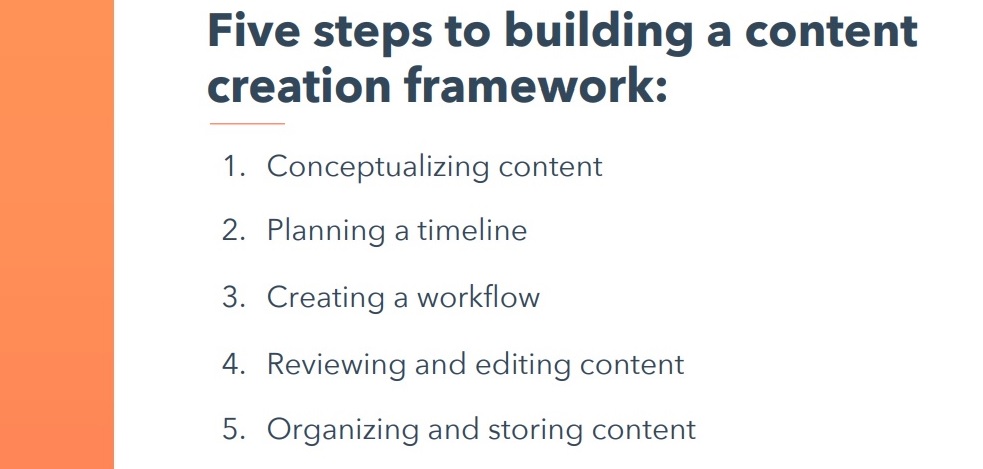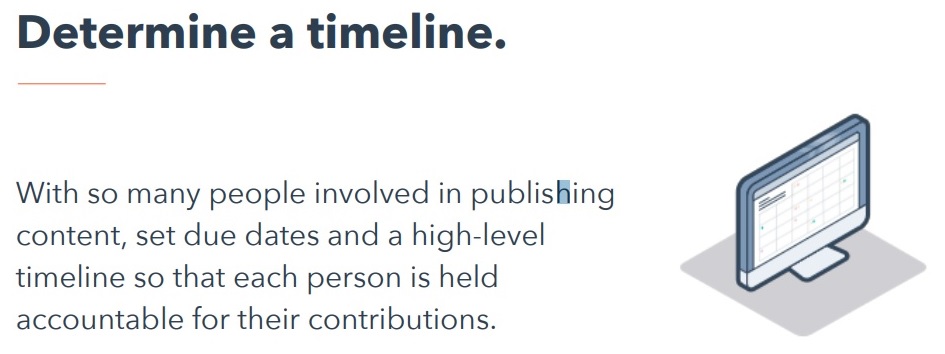Building a Content Creation Framework: A Guide for Marketers
- Home
- Building a Content Creation Framework: A Guide for Marketers
Conceptualizing Content
Before diving into content creation, it's important to lay the groundwork for any digital marketing campaign. This involves doing online research, organizing content by the buyer's journey stages, and identifying company-wide initiatives that need content support.
Online Research for Topic Generation
Start by researching online. Use keyword tools to identify trending topics and popular search terms related to your industry. Also, check out what your competitors are publishing to get inspiration and understand what resonates with your audience. Verify your assertions by obtaining reputable evidence.
Organizing Content According to Buyer's Journey Stages

Structure your content according to the buyer's journey stages: awareness, consideration, and decision. Each stage requires different types of information, so make sure your content marketing strategy reflects this.
- Awareness: Buyers are just realizing they have a problem or opportunity. Educational blogs or guides work well here.
- Consideration: Buyers now clearly define their problem/opportunity and are researching methods to address it. Comparison articles or expert webinars would be suitable.
- Decision: Finally, buyers decide on their solution approach. Product demos or customer testimonials will help them make an informed choice.
Identifying Company-Wide Initiatives Needing Content Support
Recognize company-wide initiatives needing backing from content. These could include new product launches, rebranding efforts, email nurturing initiatives or corporate social responsibility campaigns, among others. Aligning these initiatives with your inbound marketing strategies ensures maximum reach and impact while maintaining consistency across all channels. Remember: Successful inbound marketing strategies require a solid understanding of both business goals and audience needs before starting the production process.
Establishing Workflow
The second step in building a content creation framework is establishing a workflow. A well-defined workflow not only keeps your team organized but also ensures consistency across all pieces of created content. It's like the backbone that holds everything together, enabling smooth operation within teams.

Assigning Roles and Responsibilities

Firstly, it's crucial to assign roles and responsibilities. Knowing who does what can help prevent confusion or overlap in tasks. This involves identifying key players such as writers, editors, designers, paid media teams and SEO specialists and assigning them specific tasks based on their expertise.
Setting Realistic Timelines
The next step is setting realistic timelines for each task. Creating timelines should factor in the difficulty of the job and any potential impediments that could happen during its completion. Using tools like Gantt charts can be helpful here for visualizing project schedules.
Utilization of Style Guides
A style guide serves as a reference point ensuring uniformity in tone, language usage, and formatting across all produced content. Whether you're using an established guide like AP or creating your own custom one, make sure everyone involved has access to it.
Tracking Edits For Quality Control
To maintain high-quality outputs, tracking edits made during the production process becomes essential. Tools such as Google Docs' 'Suggesting' feature or Microsoft Word's 'Track Changes' function can prove beneficial here by allowing you to see exactly what changes have been made by whom.
Note:
- All edits should be reviewed before final approval to ensure accuracy and coherence with the original intent of the piece.
- Maintaining version control is another important aspect that helps avoid confusion arising from multiple versions of the same document circulating simultaneously.
- If necessary, hire professional proofreaders/editors for this purpose.
Tips:
- Create a checklist detailing every stage of the editing process.
- Incorporate feedback loops where team members review each other's work.
- Schedule regular meetings (virtual/in-person) for discussing progress/issues if any.
To build a successful content creation framework, it is important to establish a workflow that assigns roles and responsibilities, sets realistic timelines, utilizes style guides, and tracks edits for quality control. Maintaining version control and incorporating feedback loops can also help ensure consistency across all pieces of created content.
Role of Content Writers & Designers
Creating a captivating story and visually appealing designs that speak to the intended audience is an art form which requires the expertise of content writers and designers. The true art lies in crafting compelling narratives and engaging visuals that resonate with your target audience. The expertise of skilled authors and designers is essential to the success of content creation.
Importance of Professional Writing Skills
A well-crafted piece of writing can make all the difference when it comes to capturing your audience's attention and conveying your message effectively. Professional writing skills are essential for producing high-quality content that is clear, concise, and engaging.
This involves understanding how to structure sentences for readability, using appropriate tone based on context, as well as incorporating SEO keywords seamlessly into text without disrupting flow or meaning.
Editing Process Explained
The editing process goes beyond simply checking for grammatical errors or typos; it also includes ensuring consistency in style and tone across different pieces of content. A good editor will also check if the information presented is accurate, relevant to target audiences' needs while maintaining an overall coherent narrative throughout.
Here's a guide that explains more about what makes a good editing process work efficiently within any organization's framework.
Visual Design Considerations
Beyond written materials, visual design plays an integral role in enhancing user experience. From infographics to website layouts, these elements need careful planning and execution by skilled designers. They ensure that visuals complement textual content instead of overpowering them. It's crucial they align with brand guidelines too so there's uniformity across all platforms where content get published. This article delves deeper into key considerations every designer should keep in mind during their creative process.
Note:
- All team members involved must understand the importance each role plays within this framework. Both writers and editors hold responsibility towards shaping final output while designers add aesthetic appeal making material attractive and relatable to users.
- Cross-functional collaboration here ensures seamless integration between various stages from ideation to publication, thereby improving efficiency and productivity of the whole team.
The article discusses the importance of professional writing skills and visual design considerations in building a content creation framework. It emphasizes the role of writers, editors, and designers in creating compelling narratives that resonate with target audiences while ensuring consistency across different pieces of content. The editing process is explained as going beyond checking for grammatical errors to maintaining an overall coherent narrative throughout all published materials.
Tools Required for Building Frameworks
In the digital age, having the right tools at your disposal can make all the difference when it comes to building a content creation framework. These tools not only streamline processes but also ensure consistency and efficiency in your team's work.
Using CMS Efficiently
A Content Management System (CMS), like WordPress or HubSpot, is essential for managing and publishing content. It allows you to organize your materials, schedule posts, and even collaborate with other team members on projects. A good CMS will offer features such as SEO optimization capabilities, social media integration, and analytics tracking - all crucial elements of an effective inbound marketing strategy.
Leveraging Analytics Tools
Google Analytics is one tool that every marketer should have in their toolkit. By leveraging Google Analytics, you can gain valuable insights into user behavior and engagement with your content - such as clicks, page views, and session duration - which can then be used to inform your strategy. - enabling you to adjust your strategy accordingly. Other useful analytics tools include SEMRush for keyword research and Moz for backlink analysis.
Planning Tool Essentials
Planning is an integral part of achieving success in content production and should not be overlooked. Tools like Trello or Asana allow teams to plan out their editorial calendars effectively while ensuring everyone stays aligned towards common goals. They help manage tasks efficiently by setting deadlines, assigning responsibilities, and tracking progress in real-time.
- Trello: This project management app lets you create boards for different projects where you can add cards representing individual tasks.
- Asana: Another great option which offers more advanced features including Gantt charts that visualize project timelines.
Internal Communication Platform Choices
Last but certainly not least, internal communication platforms play a vital role in fostering collaboration among team members working remotely or across different time zones. Slack has emerged as a popular choice due to its user-friendly interface and robust functionality - from direct messaging, group chats, file sharing, video calls, and integrations with numerous third-party apps. Microsoft Teams is another excellent alternative offering similar features along with seamless integration within the Office 365 suite. Remember, clear communication leads directly towards better coordination, thereby resulting in efficient workflow execution.
Building a content creation framework requires the right tools, including an efficient CMS like WordPress or HubSpot, analytics tools such as Google Analytics and SEMRush, planning tools like Trello or Asana, and internal communication platforms like Slack or Microsoft Teams. Using these tools can streamline processes and ensure consistency in team workflow for successful inbound marketing strategies.
Optimizing Content for SEO
Visibility is key in the digital world. To reach a wider audience organically through search engines like Google, it's essential to optimize each piece of content you produce. Spot editing and proper organization techniques play significant roles in boosting visibility on Search Engine Result Pages (SERPs).
Understanding SEO Optimization
SEO Optimization involves more than just inserting keywords into content; it requires a comprehensive SEO strategy to increase SERP rankings. It involves a strategic approach to ensure that your website performs well or blog posts rank higher on SERPs. This includes optimizing meta tags, creating quality backlinks, improving site speed, and ensuring mobile-friendliness, among other things.
To better understand how SEO works, resources such as Moz's Beginner Guide to SEO can be invaluable for marketers looking to enhance their knowledge.
The Role of Spot Editing
A crucial part of optimizing content for SEO is spot editing - making precise changes at specific points in the text after initial drafting has been completed. These edits could include adding keywords where they fit naturally, adjusting sentence structure for readability, or inserting internal links where relevant.
The goal here isn't just keyword stuffing but enhancing overall user experience while aligning with Google's ranking algorithm, which favors high-quality content that offers value to readers.
Techniques for Better Organization
Beyond writing and editing comes the task of organizing your content effectively so it appeals both visually and contextually to users as well as search engine algorithms alike. One technique involves using headers correctly - H1s, H2s, etc., which help break down information into digestible chunks while signalling importance hierarchy within texts. Lists are another great tool; they make complex ideas simpler by breaking them down into easy-to-understand points. Furthermore, linking internally between related pieces helps keep visitors engaged longer on-site, thus reducing bounce rates - a factor considered by Google when determining page ranks.
Remember, though, that overdoing any one aspect can have negative effects too; hence balance is key here.
In essence, building an effective Content Creation Framework requires understanding various aspects from conceptualization right up to final output production, including optimization strategies necessary towards reaching desired audiences successfully via organic searches online.
So get started today; explore tools available out there, and establish workflows best suited according to needs identified during the research phase, all while keeping the focus firmly fixed upon delivering valuable experiences to end-users who matter most ultimately.
To optimize content for SEO, it's important to understand that it involves more than just incorporating keywords. Spot editing and proper organization techniques are also crucial in boosting visibility on SERPs. By using headers correctly, creating quality backlinks, improving site speed, ensuring mobile-friendliness and linking internally between related pieces of content can all help to enhance the overall user experience while aligning with Google's ranking algorithm.
FAQs in Relation to Building a Content Creation Framework
How to Build a Content Creation Framework
To create a content creation framework, you need to conceptualize ideas, establish workflows, assign roles and responsibilities, set timelines, utilize style guides, and monitor progress using tools like Google Analytics.
The 5 Steps for a Successful Content Creation Framework
The five steps include: Conceptualization of ideas, Workflow establishment, Role assignment, Timeline setting, and Monitoring & Optimization.
What is a Content Framework?
A content management system (CMS) like WordPress or HubSpot can help you organize and optimize your content according to SEO best practices.
The 3 Cs of Content Creation
- Conceptualize - Generate unique ideas through online research and keyword research.
- Create - Write professional quality articles using CMS tools like HubSpot.
- Critique - Use spot editing techniques for better organization and grammar checking.
Remember to avoid other marketing strategies not related to content creation, specific companies or brands as examples, personal experiences or anecdotes, unproven theories or speculations, and content that is irrelevant to the target audience's needs and goals.




